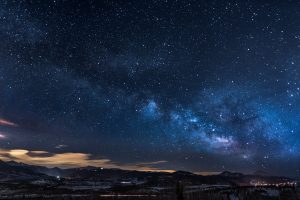
This was a chance to design and integrate a telescope and camera system using commercial, off-the-shelf drones to enable both amateur and scientific astronomy, said the sr. systems engineer for Paragon Space Development Corporation in Tucson, who has also worked as a verification systems engineer on the Large Synoptic Survey Telescope and as a systems engineer at the Gemini Observatory in Hawaii and Chile.
The result is the Astronomical Research Drone (ARD) system: an optical telescope, camera, and drone integrated into one system that provides high quality scientific astronomical imaging and spectroscopy. The ARD not only allows astronomers to image the night sky from anywhere in the world (providing both Northern and Southern hemisphere coverage), but can also be operated in weather conditions that would typically impact or altogether prevent astronomical observations; clouds, rain, water vapor, or temperature gradients are not a threat to the ARD.
By flying at altitude, above these environmental constraints, the ARD significantly reduces the effects of ground-layer turbulence and light pollution, which are both known to plague ground-based astronomical observations. For this reason, most modern observatories are built on high, remote regions of the planet, which present their own challenges. The ARD, being able to be launched from any airfield, removes both the difficulties associated with operating a remote observatory as well as the negative impacts of the environment on the scientific data.
Serio designed the ARD as his Systems Engineering capstone project.
 To tackle this challenge, Serio followed the systems engineering vee model as closely as possible. After coming up with his initial concept, he identified several key stakeholders, including friends and astronomy colleagues, and had them fill out a questionnaire to identify needs and common perspectives. This enabled him to develop user needs and key performance parameters, and from there, to generate the ARD’s system level requirements.
To tackle this challenge, Serio followed the systems engineering vee model as closely as possible. After coming up with his initial concept, he identified several key stakeholders, including friends and astronomy colleagues, and had them fill out a questionnaire to identify needs and common perspectives. This enabled him to develop user needs and key performance parameters, and from there, to generate the ARD’s system level requirements.
“I identified additional risks and updated these risks as the project matured, identifying theoretical opportunities where I could retire or burn down the risk’s severity or likelihood using different project events, such as testing, design maturation, modeling etc”., he said.
He also produced high-level functional block diagrams, updating the context diagram, requirements, and functions when inconsistencies or missing entities or interactions were found, in order to make sure everything was consistent and correct. From there, his high-level functional design was sufficiently mature to allow him to begin putting together a physical design of the system and its subsystems.
“I then produced a test plan which tied directly into my requirements and risks that I had identified from my initial and ongoing stakeholder conversations. I circled back and produced a final set of System Requirements, the A-Spec, which were all quantitative, clear, correct, complete and consistent with my Conceptual Design”, Serio said.
He believes that his new system is a realistic option for professional astronomers, but worries that the large aperture telescope he used in his final design may be too heavy, and therefore, too expensive for amateur astronomy purposes.
“I went for big aperture and high quality (expensive) optics for two reasons: the observations that can be captured with such a system will have a much more significant impact to the scientific community, and it was just a lot more fun to research!” he said.
The Systems Engineering program at Johns Hopkins Engineering regularly highlights the design projects and in-depth thesis research of its students. We will continue to make these presentations available so that they can benefit the entire systems engineering community.